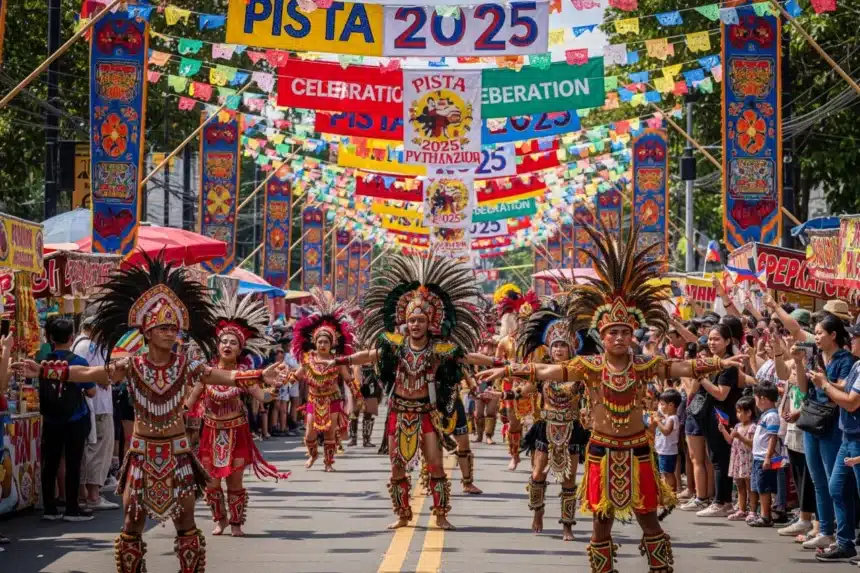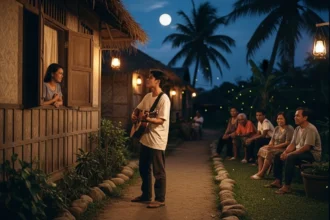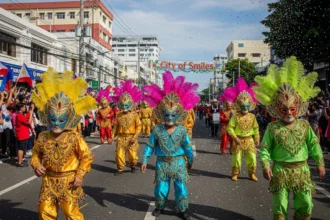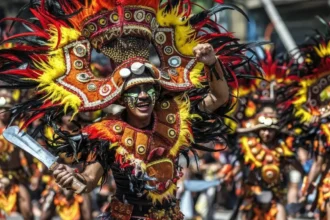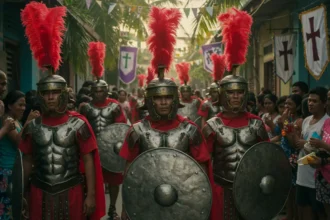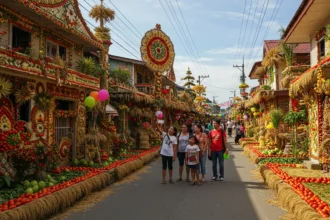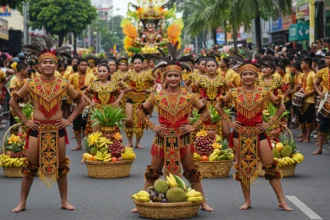Few countries celebrate like the Philippines. In 2025, Philippine festivals remain some of the most colorful, joyful, and deeply cultural events in the world. From the world-famous Sinulog Festival in Cebu to the charming Pahiyas Festival in Lucban, every month offers a chance to experience the Filipino spirit of faith, food, music, and bayanihan.
- 🎆 January Festivals in the Philippines 2025
- 🌸 February Festivals in the Philippines 2025
- 🥭 March–April Festivals in the Philippines 2025
- 🌞 May Festivals in the Philippines 2025
- 🌴 June Festivals in the Philippines 2025
- 🐚 July–August Festivals in the Philippines 2025
- 🍂 September–October Festivals in the Philippines 2025
- 🎇 November–December Festivals in the Philippines 2025
- 📊 Table: Major Philippine Festivals 2025 at a Glance
- FAQs
- 🌏 The Bigger Picture: Why Festivals Keep Pinoys United
- 🎉 References
For Pinoys, fiestas are not just celebrations-they are traditions passed down through generations. They honor patron saints, showcase regional products, and bring entire towns together in a burst of song, dance, and food. And for travelers, both local and foreign, festivals offer a glimpse into the soul of the Philippines.
If you’re planning your 2025 travels or simply want to know when to expect parades, street dancing, or traffic detours in your hometown, here’s the complete list of Philippine festivals in 2025-with dates, places, and cultural highlights you shouldn’t miss.
🎆 January Festivals in the Philippines 2025
January is the grand opening act of the festival calendar, and it doesn’t disappoint. The month kicks off with Ati-Atihan in Kalibo, Aklan, where locals and visitors paint their faces with black soot and dance nonstop to tribal drumbeats. The streets overflow with energy as performers chant “Viva kay Señor Santo Niño!” in devotion to the Holy Child. Just a week later, Sinulog in Cebu City takes the spotlight. It is one of the biggest festivals in Asia, attracting millions with its rhythmic street dancing, vibrant costumes, and a mix of religious processions and all-night parties. Then comes Dinagyang in Iloilo City, another massive tribute to the Santo Niño, featuring synchronized dance competitions among tribes, cultural parades, and grand fireworks displays. These three fiestas make January one of the most explosive months of the year-a true showcase of faith and fun blending seamlessly in the Filipino way.
Sinulog Festival (Cebu City)
- Date: January 19, 2025 (3rd Sunday of January)
- Highlight: Grand street dancing parade honoring the Santo Niño.
- Why Go: Sinulog is one of the biggest Philippine festivals 2025, attracting millions of visitors with its mix of faith and street party vibes.
Ati-Atihan Festival (Kalibo, Aklan)
- Date: January 12–19, 2025
- Highlight: Participants paint their faces with black soot while dancing to drums.
- Why Go: Dubbed the “Mother of All Philippine Festivals,” Ati-Atihan combines indigenous tradition with Catholic devotion.
Dinagyang Festival (Iloilo City)
- Date: January 26, 2025 (4th Sunday of January)
- Highlight: Tribe competitions, dance performances, and religious processions.
- Why Go: Known for its high-energy choreography and massive street parties.
🌸 February Festivals in the Philippines 2025
After the noise of January, February brings a more romantic and colorful celebration with the Panagbenga Festival in Baguio City. Known as the “Flower Festival,” Panagbenga lasts the entire month, but the highlight is the Grand Float Parade, where enormous floats covered in fresh flowers glide along Session Road, accompanied by street dancers wearing floral costumes. Aside from the parade, the festival also features cultural shows, landscaping competitions, and the Session in Bloom street fair. The cool weather of Baguio combined with the vibrant displays of roses, chrysanthemums, and sunflowers makes February a favorite month for both tourists and locals escaping the lowland heat.
Panagbenga Festival (Baguio City)
- Date: Entire month of February, with Grand Float Parade on Feb 23, 2025
- Highlight: Colorful floats decorated with fresh flowers from Benguet.
- Why Go: Known as the “Flower Festival,” Panagbenga is perfect for escaping the Manila heat and enjoying Baguio’s cool climate.
🥭 March–April Festivals in the Philippines 2025
As the Lenten season arrives, the islands of Marinduque become the stage for the Moriones Festival, one of the country’s most unique religious events. During Holy Week, townspeople don wooden masks and costumes of Roman centurions, reenacting the story of Longinus, the blind soldier who pierced Christ’s side and was later converted. The streets are filled with processions, passion plays, and dramatic chases of masked performers. At the same time, in Bicol, the Magayon Festival in Albay celebrates the legend of Mayon Volcano with cultural parades, street dances, and beauty pageants. Visitors are treated to a mix of folklore and Bicolano pride, with plenty of spicy food to sample along the way. March and April in the Philippines are months when faith and legend intertwine, offering both solemn reflection and festive thanksgiving.
Moriones Festival (Marinduque)
- Date: Holy Week (April 13–19, 2025)
- Highlight: Locals wear Roman soldier masks reenacting the story of Longinus.
- Why Go: Unique blend of religious devotion and theatrical street performance.
Magayon Festival (Albay, Bicol)
- Date: April 2025 (exact schedule TBA)
- Highlight: Street dancing, parades, and beauty pageants.
- Why Go: Celebrates the legend of Mayon Volcano’s perfect cone.
🌞 May Festivals in the Philippines 2025
May is the peak of fiesta season, and almost every town has its own celebration. The most famous is the Pahiyas Festival in Lucban, Quezon, where houses are transformed into canvases of creativity, decorated with colorful “kiping” (rice wafers), fruits, vegetables, and handicrafts. This festival is both a thanksgiving for a bountiful harvest and a feast for the eyes, with streets bursting in rainbow colors. Meanwhile, across the country, Flores de Mayo and Santacruzan take over barangays and parishes. In this month-long devotion to the Virgin Mary, processions feature young women dressed in elaborate gowns, carrying flowers, and representing historical and biblical figures. The combination of faith, fashion, and pageantry makes May one of the most beloved months for Filipino festivals, drawing both pilgrims and casual tourists alike.
Pahiyas Festival (Lucban, Quezon)
- Date: May 15, 2025
- Highlight: Houses decorated with colorful “kiping” (rice wafers).
- Why Go: One of the most photogenic festivals, perfect for Instagram-worthy shots.
Flores de Mayo / Santacruzan (Nationwide)
- Date: Entire month of May, processions peak in late May
- Highlight: Processions of women in gowns representing biblical and historical figures.
- Why Go: A mix of faith, fashion, and tradition celebrated in barangays across the country.
🌴 June Festivals in the Philippines 2025
June brings the rainy season but also keeps spirits high with celebrations like the Pintados-Kasadyaan Festival in Tacloban, Leyte. Here, participants paint their bodies with elaborate patterns, echoing the traditions of ancient warriors. The festival features ritual dances honoring the Santo Niño, cultural competitions, and street pageants. This event not only entertains but also reconnects the community to its pre-colonial roots, blending indigenous heritage with Christian devotion. June’s festivals remind Filipinos of the deep history embedded in their traditions.
Pintados-Kasadyaan Festival (Tacloban, Leyte)
- Date: June 29, 2025
- Highlight: Painted warriors dancing in honor of Sto. Niño.
- Why Go: Prepares the city for the grander Sangyaw Festival.
🐚 July–August Festivals in the Philippines 2025
By mid-year, the Visayas and Mindanao take center stage. In July, Bohol commemorates its history with the Sandugo Festival in Tagbilaran, marking the blood compact between Datu Sikatuna and Spanish explorer Miguel López de Legazpi. Street dancing, historical reenactments, and trade fairs highlight the unity theme of this event. Then, in August, Davao City explodes with color during the Kadayawan Festival, one of Mindanao’s most celebrated fiestas. Kadayawan is a thanksgiving for the city’s rich harvest of fruits and flowers, but it also honors the 11 indigenous tribes of Davao. Visitors can enjoy street dancing, floral floats, tribal showcases, and endless food fairs featuring durian, pomelo, and other Davao delicacies. These festivals prove that mid-year celebrations are as grand and meaningful as those at the start of the year.
Sandugo Festival (Tagbilaran, Bohol)
- Date: July 2025 (last week)
- Highlight: Commemorates the blood compact between Datu Sikatuna and Miguel López de Legazpi.
- Why Go: Mix of historical pageantry and cultural showcases.
Kadayawan Festival (Davao City)
- Date: August 17–24, 2025
- Highlight: Floral floats, tribal dances, and a celebration of Davao’s harvest.
- Why Go: Davao’s biggest festival, highlighting indigenous culture and fruits like durian and pomelo.
🍂 September–October Festivals in the Philippines 2025
As the “ber” months begin, the cultural richness of the Philippines shines even brighter. In September, Peñafrancia Festival in Naga City draws thousands of devotees for its fluvial procession along the Naga River, where the image of Our Lady of Peñafrancia is carried on a decorated pagoda. It’s one of the largest Marian festivals in Asia, combining faith and spectacle in a deeply moving event.
By October, the country celebrates not just one, but two of its most famous fiestas. In Bacolod City, the MassKara Festival transforms the streets with smiling masks, flamboyant costumes, and endless street parties, symbolizing Bacolod’s resilience and optimism. Meanwhile, in Zamboanga City, the Zamboanga Hermosa Festival (Fiesta Pilar) honors the city’s beloved patroness, the Virgen del Pilar. This month-long celebration includes novenas, processions, cultural fairs, and the breathtaking Regatta de Zamboanga, where vintas with colorful sails race across the sea. Together, MassKara and Zamboanga Hermosa make October a powerful showcase of Filipino devotion, artistry, and maritime heritage.
Peñafrancia Festival (Naga City, Camarines Sur)
- Date: September 20, 2025 (3rd Saturday of September)
- Highlight: Fluvial procession along the Naga River.
- Why Go: One of the largest Marian festivals in Asia.
Zamboanga Hermosa Festival (Zamboanga City, Zamboanga del Sur)
- Date: October 1–31, 2025 (Fiesta Pilar falls on October 12)
- Highlight: Regatta de Zamboanga featuring colorful vintas, grand religious processions, and cultural shows.
- Why Go: The Zamboanga Hermosa Festival, also known as Fiesta Pilar, is a month-long celebration honoring Nuestra Señora La Virgen del Pilar, the city’s patroness. It’s a spectacular mix of faith, history, and maritime tradition, with the vinta regatta standing out as one of the most iconic sights in Philippine festivals.
MassKara Festival (Bacolod City)
- Date: October 19, 2025 (3rd Sunday of October)
- Highlight: Dancers in smiling masks and sequined costumes.
- Why Go: Known as the “Festival of Smiles,” MassKara started as a way for Bacolod to uplift spirits during a crisis.
🎇 November–December Festivals in the Philippines 2025
The year closes with art and Christmas cheer. November hosts the Higantes Festival in Angono, Rizal, where giant papier-mâché effigies, some over ten feet tall, march down the streets. Angono is known as the art capital of the Philippines, and this festival is its grandest showcase, blending humor, creativity, and community. By December, Pampanga cements its reputation as the “Christmas Capital of the Philippines” with the Giant Lantern Festival in San Fernando. Massive lanterns, some reaching 20 feet in diameter, compete in a dazzling display of light and design. The event attracts thousands of visitors who marvel at the artistry and engineering behind the lanterns, making December not just merry but also magical.
Higantes Festival (Angono, Rizal)
- Date: November 22–23, 2025
- Highlight: Giant papier-mâché effigies parading through the streets.
- Why Go: Reflects Angono’s reputation as the art capital of the Philippines.
Giant Lantern Festival (San Fernando, Pampanga)
- Date: December 20, 2025
- Highlight: Enormous, illuminated Christmas lanterns compete in a grand display.
- Why Go: Called the “Christmas Capital of the Philippines,” Pampanga shines brightest during this festival.
📊 Table: Major Philippine Festivals 2025 at a Glance
| Month | Festival | Location | Date (2025) | Highlight |
|---|---|---|---|---|
| January | Sinulog | Cebu City | Jan 19 | Street dancing, Santo Niño |
| January | Ati-Atihan | Kalibo, Aklan | Jan 12–19 | Tribal dance, black soot face |
| January | Dinagyang | Iloilo City | Jan 26 | High-energy dance contests |
| February | Panagbenga | Baguio City | Feb 23 (parade) | Flower floats |
| April | Moriones | Marinduque | Apr 13–19 (Holy Week) | Roman mask street drama |
| May | Pahiyas | Lucban, Quezon | May 15 | Colorful “kiping” decorations |
| May | Flores de Mayo | Nationwide | Entire May | Processions, Santacruzan |
| August | Kadayawan | Davao City | Aug 17–24 | Tribal dances, floral floats |
| October | MassKara | Bacolod City | Oct 19 | Smiling masks and parades |
| December | Giant Lantern | Pampanga | Dec 20 | Lantern competition |
FAQs
1. Which is the biggest Philippine festival in 2025?
The Sinulog Festival in Cebu is considered the biggest, drawing millions of participants and tourists every January. It combines faith and grand street parades.
2. Are all Philippine festivals religious?
Not all. While many honor patron saints, some festivals highlight harvests, local products, or historical events such as the Sandugo Festival in Bohol.
3. Do I need to book flights early for major festivals?
Yes. For big events like Sinulog, Panagbenga, and MassKara, it’s best to book flights and hotels months in advance since slots sell out quickly.
4. Are Philippine festivals tourist-friendly?
Very much. Locals are welcoming, and cities prepare safety and traffic management plans. Tourists are encouraged to join but should always respect cultural and religious aspects.
5. Can I experience festivals outside of Luzon?
Definitely. Some of the most vibrant fiestas are in Visayas and Mindanao-like Dinagyang in Iloilo, Ati-Atihan in Aklan, and Kadayawan in Davao.
6. What should I bring when attending festivals?
Bring light clothing, cash (since not all vendors accept cards), bottled water, and secure your belongings. Comfortable shoes are a must for walking and dancing in the streets.
7. Are there smaller, lesser-known festivals worth visiting?
Yes. Almost every town in the Philippines has its own fiesta. Exploring these local festivals gives you a more intimate experience with Filipino culture.
8. Do festivals in the Philippines have entrance fees?
Most are free to attend, though certain concerts or events within the festival may require tickets. The street parades, processions, and fairs are open to everyone.
🌏 The Bigger Picture: Why Festivals Keep Pinoys United
Philippine festivals are more than just parades and costumes. They are proof of the country’s resilience and joy. Every year, even during tough times, Filipinos find ways to celebrate-whether it’s through Ati-Atihan drums in Aklan, giant lanterns in Pampanga, or smiling masks in Bacolod.
For locals, fiestas are reminders of tradition and faith. For businesses, they boost local tourism and livelihoods. For travelers, they offer unforgettable snapshots of Pinoy culture. But above all, festivals show what it means to be Filipino: masayahin, hospitable, and full of life.
As 2025 unfolds, these festivals will once again turn streets into stages, towns into living canvases, and ordinary days into extraordinary moments. And whether you’re a balikbayan looking for home or a tourist curious about our culture, one thing’s for sure: in the Philippines, there’s always a fiesta waiting for you.
🎉 References
-
TPB – Calendar of Philippine Festivals & Monthly Observances
-
Wikipedia – List of Festivals in the Philippines
-
Traveloka – Top 20 Philippine Festivals to Attend in 2025
-
Guide to the Philippines – 2025 Philippines Holidays and Festival Calendar
-
Holidify – 12 Festivals in the Philippines
-
TripAdvisor – 10 Best Philippines Cultural Events (2025)



